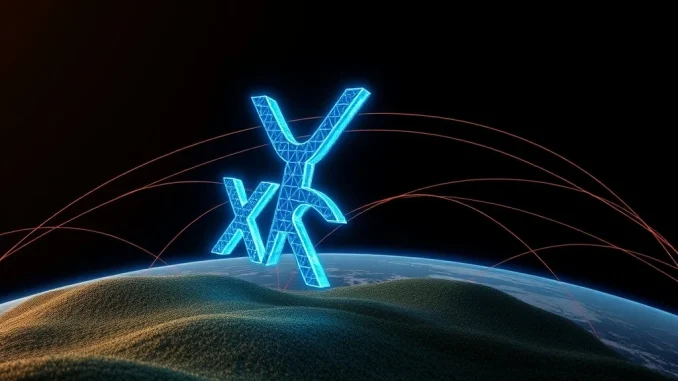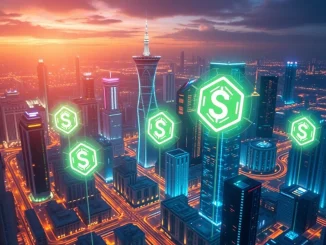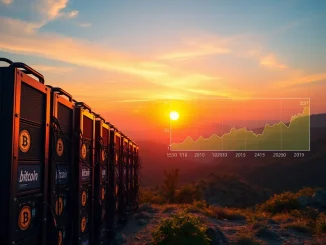
The global financial landscape is on the cusp of a profound transformation. For decades, SWIFT has been the undisputed backbone of international transactions, connecting over 11,000 institutions worldwide. But what if this entrenched system, once a symbol of global connectivity, is now facing its most formidable challenger? Enter XRP, a digital asset at the forefront of a movement poised to redefine cross-border payments, driven by unparalleled blockchain efficiency and shifting geopolitical tides.
The Legacy Burden: Why SWIFT’s Grip on Global Payments is Weakening
SWIFT (Society for Worldwide Interbank Financial Telecommunication) has served its purpose for nearly 50 years, enabling secure messaging between financial institutions. However, its foundational architecture, while robust for its time, presents significant drawbacks in today’s fast-paced digital economy:
- Sluggish Processing Times: International transfers can take days, often due to multiple intermediary banks in the transaction chain.
- High Costs: Each intermediary bank can levy fees, accumulating significant costs, especially for smaller transactions or high volumes.
- Lack of Real-Time Settlement: Transactions are not settled instantly, leading to delays in fund availability and liquidity management challenges.
- Operational Complexity: The multi-party system often results in reconciliation issues and a lack of transparency regarding transaction status.
As analyst Pumpius suggests, these inefficiencies are pushing the traditional SWIFT system towards obsolescence. The world demands speed, transparency, and lower costs, a demand that legacy systems struggle to meet.
XRP’s Unrivaled Blockchain Efficiency: The New Standard
In stark contrast to SWIFT, XRP leverages advanced blockchain technology to offer a radically different approach to international transfers. Its core advantages lie in its ability to facilitate near-instant transactions at a fraction of a cent, bypassing intermediaries entirely. This provides:
- Near-Instant Settlement: Transactions on the XRP Ledger (XRPL) are confirmed in 3-5 seconds, offering true real-time settlement.
- Minimal Costs: Transaction fees are incredibly low, often less than a penny, making micro-payments and large transfers economically viable.
- Enhanced Liquidity: XRP acts as a bridge currency, enabling On-Demand Liquidity (ODL) for financial institutions to convert fiat currencies quickly without pre-funding accounts in destination currencies.
- Transparency and Finality: Every transaction is recorded on a public, immutable ledger, providing clear audit trails and transaction finality.
RippleNet, Ripple’s global payments network, is central to XRP’s ascent. Over 100 financial institutions worldwide have integrated Ripple’s ODL system, which utilizes XRP to facilitate efficient cross-border payments. This infrastructure positions XRP as a ‘new chesspiece’ in global finance, filling gaps where SWIFT’s centralized model falls short.
Geopolitical Shifts and the Rise of a Neutral Digital Economy
Beyond technological superiority, geopolitical dynamics are significantly accelerating the shift away from traditional systems. The ‘weaponization’ of SWIFT, such as excluding certain nations from the network for political reasons, has highlighted the need for politically neutral alternatives. This has spurred a demand for decentralized and globally accessible payment rails.
XRP‘s decentralized architecture and global reach align perfectly with this need. Its design ensures no single entity can control the network, making it an attractive option for institutions wary of geopolitical risks and seeking a neutral conduit for value transfer. As Pumpius states, “SWIFT’s last sunset isn’t just about technology, it’s about control.” The ongoing power shift from legacy institutions to decentralized networks positions XRP as a viable bridge between the old financial world and the emerging digital economy.
Furthermore, countries exploring Central Bank Digital Currencies (CBDCs) are increasingly considering the XRP Ledger (XRPL) for interoperability solutions. The XRPL’s robust infrastructure and proven track record make it a strong candidate for connecting various CBDC networks, further amplifying its strategic relevance in a future where digital currencies are commonplace.
Tracking XRP’s Momentum: Adoption and Future Projections
The growing interest in XRP is evident in its user base. The XRP Ledger’s active wallets recently hit a record 7.24 million, reflecting robust retail and institutional engagement. This growth is driven by several factors:
- Cross-Border Adoption: More financial institutions and payment providers are leveraging XRP for efficient international transfers.
- Real-World Asset Tokenization: The XRPL’s capabilities for tokenizing real-world assets (RWAs) are attracting new use cases and users.
- Institutional Validation: Increasing partnerships and pilot programs with major financial players lend credibility and drive adoption.
On-chain analytics indicate a convergence of the XRPL ecosystem with mainstream financial infrastructure. Experts project that up to 14% of global payment volume could migrate to the ledger in the coming years. This projection, if realized, would represent a monumental shift in how money moves across borders, cementing XRP’s role as a dominant force in the future of finance.
Conclusion: A New Era for Global Payments
While the complete decline of SWIFT remains a subject of ongoing discussion, the confluence of technological innovation, geopolitical realignments, and surging user adoption paints a compelling picture for XRP‘s role in the future of finance. The transition from a slow, costly, and centralized system to a fast, affordable, and decentralized one is not merely an upgrade; it’s a fundamental re-imagining of how global value is exchanged.
As the XRP Ledger’s wallet count and transaction activity continue to rise, the industry watches closely to see if this digital asset can sustain its momentum and solidify its position as the preferred alternative to legacy systems for cross-border payments. The revolution is underway, and XRP is leading the charge into a more efficient, inclusive, and neutral digital economy.
Frequently Asked Questions (FAQs)
Q1: What is the primary difference between XRP and SWIFT?
The primary difference is their underlying technology and operational model. SWIFT is a messaging network that facilitates traditional bank transfers, which can be slow and costly due to multiple intermediaries. XRP, on the other hand, is a digital asset that leverages blockchain technology to enable near-instant, low-cost, and direct cross-border payments, bypassing intermediaries.
Q2: How does XRP achieve faster and cheaper cross-border payments?
XRP achieves this through its native blockchain, the XRP Ledger (XRPL). It acts as a bridge currency, allowing financial institutions to convert one fiat currency to another almost instantly and at minimal cost via Ripple’s On-Demand Liquidity (ODL) service. This eliminates the need for pre-funded nostro/vostro accounts and reduces reliance on traditional correspondent banking.
Q3: What role do geopolitical shifts play in XRP’s rise?
Geopolitical shifts, particularly the ‘weaponization’ of SWIFT by excluding certain nations, have highlighted the need for politically neutral and decentralized alternatives. XRP’s architecture, being decentralized and global, offers a solution for countries and institutions seeking to mitigate geopolitical risks associated with centralized payment systems.
Q4: What is the XRP Ledger (XRPL) and its significance for CBDCs?
The XRP Ledger (XRPL) is the open-source, decentralized blockchain that powers XRP. Its significance for Central Bank Digital Currencies (CBDCs) lies in its ability to provide interoperability solutions. Many countries exploring CBDCs are considering the XRPL as a platform to connect different national digital currencies, enabling seamless cross-border CBDC transactions.
Q5: Is XRP’s challenge to SWIFT guaranteed to succeed?
While XRP presents a compelling alternative with significant advantages, its complete replacement of SWIFT is still speculative. SWIFT is a deeply entrenched system with a vast network. However, the increasing adoption of XRP, its technological superiority, and the growing demand for efficient and neutral payment solutions suggest a strong potential for XRP to capture a significant share of the global payment volume.



